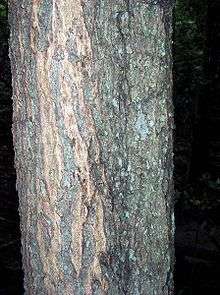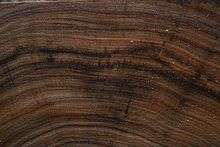Acacia elata
| Cedar wattle | |
|---|---|
 | |
| trunk of Acacia elata, Blue Mountains National Park, Australia | |
 | |
| Cross-section of Acacia elata log | |
| Scientific classification | |
| Kingdom: | Plantae |
| Clade: | Angiosperms |
| Clade: | Eudicots |
| Clade: | Rosids |
| Order: | Fabales |
| Family: | Fabaceae |
| Clade: | Mimosoideae |
| Genus: | Acacia |
| Species: | A. elata |
| Binomial name | |
| Acacia elata | |
| Synonyms | |
| |
Acacia elata, illustration
Acacia elata the cedar wattle or mountain cedar wattle is a tree found in eastern Australia.[2] Often up to 18 metres tall when mature, exceptional specimens reach over 30 metres. The habitat is near rainforest and wet sclerophyll forest in various situations. An attractive plant with delicate foliage, it is sometimes seen in cultivation. Its timber is attractive, close-grained, strong and hard, and is suitable for carpentry and turning.
It is sometimes escaping from gardens and is considered as a weed in wetter Warren region from Western Australia.
References
- ↑ ILDIS LegumeWeb
- ↑ "Acacia elata". PlantNET - NSW Flora Online. Retrieved 2010-07-25.
| Wikimedia Commons has media related to Acacia elata. |
Further reading
- Castro-Diez, P.; Langendoen, T.; Poorter, L.; Saldana-Lopez, A. (November 2011). "Predicting Acacia invasive success in South Africa on the basis of functional traits, native climatic niche and human use". Biodiversity and Conservation. 20 (12): 2729–2743. doi:10.1007/s10531-011-0101-5. Retrieved 1 May 2015.
- Donaldson, J.E.; Richardson, D.M.; Wilson, J.R.U. (September 2014). "The seed ecology of an ornamental wattle in South Africa — Why has Acacia elata not invaded a greater area?". South African Journal of Botany. 94 (1): 40–45. doi:10.1016/j.sajb.2014.05.004.
- Korit, Alexander; Jermyn, Michael (March 3, 2005). "Acacia Proteinase Inhibitors Purification and Properties of the Trypsin Inhibitors from Acacia elutu Seed". European Journal of Biochemistry. 115 (3): 551–557. doi:10.1111/j.1432-1033.1981.tb06238.x.
- Rehman, S.; Harris, P. J. C.; Bourne, W.F. (1998). "The effect of seed hardening on the salinity tolerance of Acacia seeds". Seed Science and Technology. 26 (3): 743–754.
This article is issued from
Wikipedia.
The text is licensed under Creative Commons - Attribution - Sharealike.
Additional terms may apply for the media files.